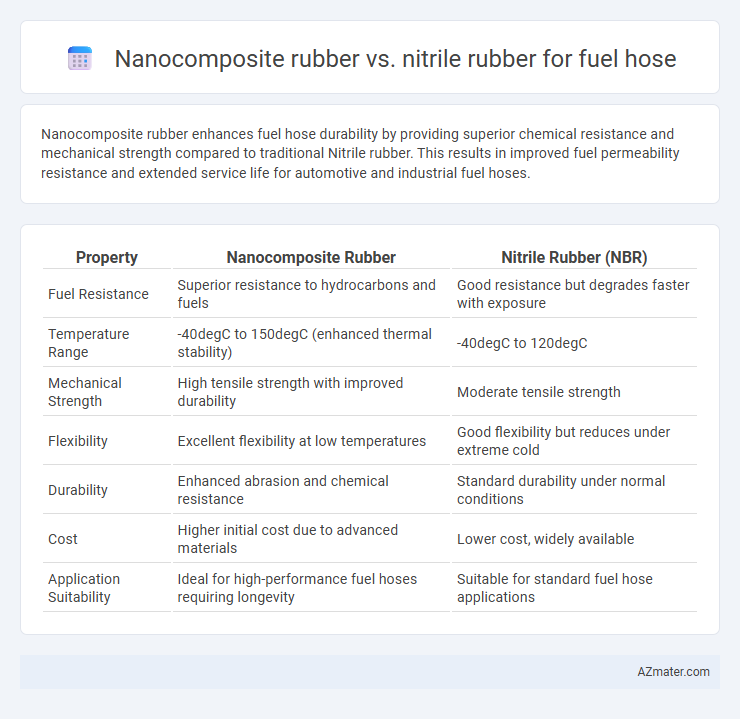Nanocomposite rubber enhances fuel hose durability by providing superior chemical resistance and mechanical strength compared to traditional Nitrile rubber. This results in improved fuel permeability resistance and extended service life for automotive and industrial fuel hoses.
Table of Comparison
| Property | Nanocomposite Rubber | Nitrile Rubber (NBR) |
|---|---|---|
| Fuel Resistance | Superior resistance to hydrocarbons and fuels | Good resistance but degrades faster with exposure |
| Temperature Range | -40degC to 150degC (enhanced thermal stability) | -40degC to 120degC |
| Mechanical Strength | High tensile strength with improved durability | Moderate tensile strength |
| Flexibility | Excellent flexibility at low temperatures | Good flexibility but reduces under extreme cold |
| Durability | Enhanced abrasion and chemical resistance | Standard durability under normal conditions |
| Cost | Higher initial cost due to advanced materials | Lower cost, widely available |
| Application Suitability | Ideal for high-performance fuel hoses requiring longevity | Suitable for standard fuel hose applications |
Introduction to Fuel Hose Materials
Nanocomposite rubber enhances traditional fuel hose performance by integrating nanoparticles into the polymer matrix, improving fuel resistance, flexibility, and durability compared to conventional nitrile rubber. Nitrile rubber (NBR) is widely used for fuel hoses due to its excellent resistance to oils, fuels, and abrasion, but may suffer from aging and limited thermal stability. Utilizing nanocomposite rubber materials in fuel hoses results in superior mechanical strength and extended service life under harsh operating conditions, making them a cutting-edge alternative to standard nitrile rubber.
Overview of Nanocomposite Rubber
Nanocomposite rubber incorporates nanoscale fillers such as carbon nanotubes or graphene to significantly enhance mechanical strength, thermal stability, and fuel resistance compared to conventional nitrile rubber. These advanced materials improve fuel hose durability by offering superior resistance to swelling, abrasion, and chemical degradation under harsh fuel environments. Nanocomposite technology enables fuel hoses to achieve extended service life and better performance in demanding automotive and industrial applications.
What is Nitrile Rubber?
Nitrile rubber (NBR), a synthetic copolymer of acrylonitrile and butadiene, is widely used in fuel hoses due to its excellent resistance to oils, fuels, and other hydrocarbons. Nanocomposite rubber enhances traditional nitrile formulations by incorporating nanoscale fillers like carbon nanotubes or silica, improving mechanical strength, thermal stability, and fuel resistance. This advanced material significantly extends fuel hose durability and performance under harsh operating conditions compared to standard nitrile rubber.
Chemical Resistance Comparison
Nanocomposite rubber exhibits superior chemical resistance compared to nitrile rubber, particularly in exposure to hydrocarbons, fuels, and oils commonly encountered in fuel hose applications. The incorporation of nanoparticles in nanocomposite rubber enhances barrier properties and reduces permeation of aggressive chemicals, resulting in increased durability and longer service life. Nitrile rubber, while offering good resistance to petroleum-based fluids, may degrade faster under prolonged exposure to certain solvents and fuels, making nanocomposite rubber a more advanced choice for demanding chemical environments.
Mechanical Properties and Durability
Nanocomposite rubber for fuel hoses exhibits superior mechanical properties, including enhanced tensile strength and abrasion resistance, compared to traditional nitrile rubber. The incorporation of nanofillers such as carbon nanotubes or silica particles significantly improves the elasticity, tensile modulus, and fatigue resistance, resulting in exceptional durability under harsh fuel exposure and high-pressure conditions. This leads to extended service life and improved performance in automotive and industrial fuel hose applications.
Flexibility and Temperature Performance
Nanocomposite rubber for fuel hoses offers enhanced flexibility and superior temperature performance compared to traditional nitrile rubber, maintaining elasticity at temperatures ranging from -40degC to 150degC. The incorporation of nanofillers in nanocomposite rubber improves thermal stability and resistance to fuel permeation, extending hose lifespan under harsh operating conditions. Nitrile rubber, while cost-effective and fuel-resistant, typically exhibits reduced flexibility and performance degradation above 120degC, limiting its application in high-temperature environments.
Fuel Permeability and Safety
Nanocomposite rubber exhibits significantly lower fuel permeability compared to traditional nitrile rubber, enhancing its effectiveness as a fuel hose material by reducing vapor loss and environmental emissions. The incorporation of nanoparticles in nanocomposite rubber creates a dense barrier that dramatically improves resistance to fuel permeation, thereby increasing overall safety in fuel transport applications. This improved barrier property not only extends the hose's lifespan but also minimizes the risk of fire hazards and exposure to harmful hydrocarbons, ensuring safer operation in automotive and industrial fuel systems.
Lifespan and Maintenance Considerations
Nanocomposite rubber fuel hoses exhibit significantly enhanced lifespan due to superior resistance to fuel permeation, oxidation, and thermal degradation compared to conventional nitrile rubber hoses. Maintenance requirements for nanocomposite rubber are reduced as their improved durability minimizes cracking and swelling, resulting in fewer replacements and lower downtime. In contrast, nitrile rubber hoses, while cost-effective initially, often require more frequent inspection and replacement due to faster wear under harsh fuel conditions.
Cost and Manufacturing Differences
Nanocomposite rubber exhibits enhanced mechanical properties and fuel resistance compared to nitrile rubber, leading to longer service life but at a higher initial material cost. Manufacturing nanocomposite fuel hoses involves advanced mixing and dispersion techniques to uniformly integrate nanoparticles, increasing production complexity and expense relative to conventional nitrile rubber processing. Despite higher upfront costs, nanocomposite hoses can offer better fuel permeation resistance and durability, potentially reducing long-term maintenance and replacement expenses compared to standard nitrile rubber hoses.
Application Suitability: Nanocomposite vs Nitrile
Nanocomposite rubber exhibits enhanced fuel resistance, abrasion durability, and thermal stability, making it highly suitable for demanding fuel hose applications in automotive and industrial sectors. Nitrile rubber, known for its excellent oil and fuel resistance, remains a cost-effective choice but may degrade faster under high temperature and mechanical stress compared to nanocomposite variants. Selecting nanocomposite rubber improves hose lifespan and performance in aggressive fuel environments, while nitrile rubber suits standard fuel delivery systems with moderate operating conditions.

Infographic: Nanocomposite rubber vs Nitrile rubber for Fuel hose
 azmater.com
azmater.com